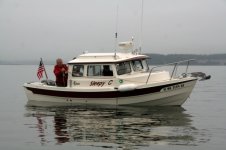Casey
New member
- Joined
- Nov 2, 2003
- Messages
- 1,094
- Reaction score
- 0
- C Dory Year
- 2006
- C Dory Model
- 23 Venture
- Hull Identification Number
- GXK23017A606
- Vessel Name
- "Dessert 1st"
Thanks Jay (and others too...),
I've been enjoying the narrative and pictures of your latest Southeast AK trip; a Great area for sure! Current plans call for us to go back to Southeast next summer. We may even leave Naknek on her trailer in Wrangell for subsequent summer boating seasons (...that's still on the drawing board). The only downside with that is it would preclude trips to Powell ... dang.
I agree with you - I probably wouldn't want to cruise in a C-Dory without sufficient power to get Naknek on plane. Cruising at displacement speed is very enjoyable (and I TOTALLY agree with you regarding autopilot...), but having the power to push her on plane is very good as well - whether it's to "get there," run from wx, or whatever.
That said - I suspect when we eventually have to repower Naknek I'll look VERY seriously at going with the twin engine configuration. Inspiteof a few downside issues (twice the moving parts, increased lower unit drag, etc.) having the option to displacement cruise Very economically, yet still get up on plane when wanted, is very appealing. Then there is the whole redundancy argument for twins. Who knows - somewhere down the road somebody may even offer smaller 4-strokes with a counter-rotation option (...dream-on Casey!)
Happily, with only 540 hours on the Suzi it should be a Long time until we have to make a choice. ...but it's fun to think about!
Casey
C-Dory Naknek
I've been enjoying the narrative and pictures of your latest Southeast AK trip; a Great area for sure! Current plans call for us to go back to Southeast next summer. We may even leave Naknek on her trailer in Wrangell for subsequent summer boating seasons (...that's still on the drawing board). The only downside with that is it would preclude trips to Powell ... dang.
I agree with you - I probably wouldn't want to cruise in a C-Dory without sufficient power to get Naknek on plane. Cruising at displacement speed is very enjoyable (and I TOTALLY agree with you regarding autopilot...), but having the power to push her on plane is very good as well - whether it's to "get there," run from wx, or whatever.
That said - I suspect when we eventually have to repower Naknek I'll look VERY seriously at going with the twin engine configuration. Inspiteof a few downside issues (twice the moving parts, increased lower unit drag, etc.) having the option to displacement cruise Very economically, yet still get up on plane when wanted, is very appealing. Then there is the whole redundancy argument for twins. Who knows - somewhere down the road somebody may even offer smaller 4-strokes with a counter-rotation option (...dream-on Casey!)
Happily, with only 540 hours on the Suzi it should be a Long time until we have to make a choice. ...but it's fun to think about!
Casey
C-Dory Naknek

